Mahabalipuram: Ancient Ruined City And Its Marvellous Rock-Cut Architecture In South India
Angela Sutherland - AncientPages.com - Mahabalipuram is a ruined city located on the coast just 60 km south of Chennai. Even looking at the city’s ruins, it is obvious the place represents one of the most famous examples of ancient Indian art and architecture.
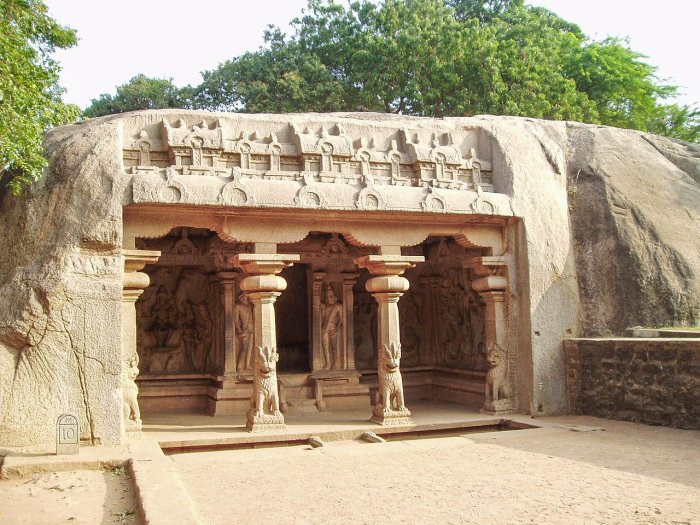 Varaha cave temple entrance. Image credit: Vsundar - CC BY-SA 3.0
Varaha cave temple entrance. Image credit: Vsundar - CC BY-SA 3.0
This Pallava old site has some of the earliest examples of architecture in South India, rock-cut cave temples, stone carvings, and the shore temple on the beach.
During the 7th to 10th centuries, it was a flourishing seaport (one of two) of the Pallava Dynasty of rulers, situated in the southeastern Indian state of Tamil Nadu.
In Mahabalipuram (also known as Mamallapuram), especially the Hindu Group of Monuments are famous landmarks because they represent the impressive architectural legacy of the Pallava rulers, and they are artistic and technical wonders. The city was prosperous economically and had a complex of royal monuments, of which several were carved out of living rock.
Mahabalipuram represents not only Dravidian architectural style. The Chola architecture highly influences this style and techniques used by other dynasties that followed.
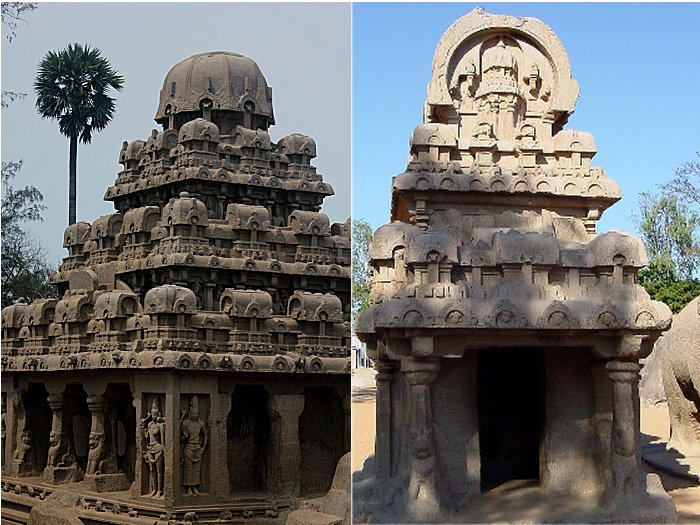 Left: Arjuna Ratha, Image credit: Xcibaangel- CC BY-SA 3.0; Right: Nakula Sahadeva Ratha. Image credit: G41rn8 - CC BY-SA 4.0
Left: Arjuna Ratha, Image credit: Xcibaangel- CC BY-SA 3.0; Right: Nakula Sahadeva Ratha. Image credit: G41rn8 - CC BY-SA 4.0
The city’s stone structures include mandapas (cave sanctuaries), which were typically built as a square vestibule, hall with pillars, or pavilion. Cells or sanctums would often be included, creating facilities for dwellings (vihara). The mandapas were used for people to gather socially, usually for ceremonies and rite-of-passage rituals.
There are many mandapas at Mahabalipuram, all dated to the 7th and 8th centuries. Other monuments are: the Rathas (‘chariots to the gods’) - striking rock-cut temples carved out of a single boulder, in the form of chariots, and dated to 600AD and 800 AD.
These rock-cut temples, named after the five Pandava brothers (Arjuna, Yudhistira, Bhima, Nakula, and Sahadeva) demigod warrior princes, and the heroes of the ancient Sanscrit epic poem Mahabharata are the outstanding examples of Pallava art.
Left: Dharmaraja‘s Ratha. Credit: Samrajclicks - CC BY-SA 4.0 - Right: Draupathi Ratha. Credit: Samrajclicks - CC BY-SA 4.0
Rathas – the full-sized models - recall the earlier architecture of the Buddhist chapels and monasteries. The architecture resembles Dravidian temples with their grand towers, sculptured walls, and halls decorated with Dravidian-style pillars.
Mahendravarman I (600-630 AD) was a great supporter of the arts. He had a passion for religion, so he introduced rock-cut architecture to the Pallava Dynasty.
He wanted both temples and artwork that decorated them to survive both weather and the passing of time. Therefore, he used a rock as a building material to better preserve the temples.
When he died, the temples were still not completed in the city of Mahabalipuram. His son was not so interested in art as his father, and he preferred to develop his military skills instead. The five temples have never been built, like his father, Mahendravarman, intended to do.
Bhima Ratha. Credit: Zuhebkhan94 - CC BY-SA 4.0
They stand unfinished until today and are called the Five Rathas of Mahabalipuram.
Another stone structure, the Shore Temple dedicated to the god Shiva is also one of Mahabalipuram’s most noted landmarks. Today, the facility is eroded and somewhat ruined, but it still holds many artistic details intact.
However, interestingly, this temple clearly shows a change in temple construction. The nearby five rathas are rock-hewn monoliths; the Shore Temple, on the other hand, is stone-built. It is considered one of the earliest stone-built temples in India.
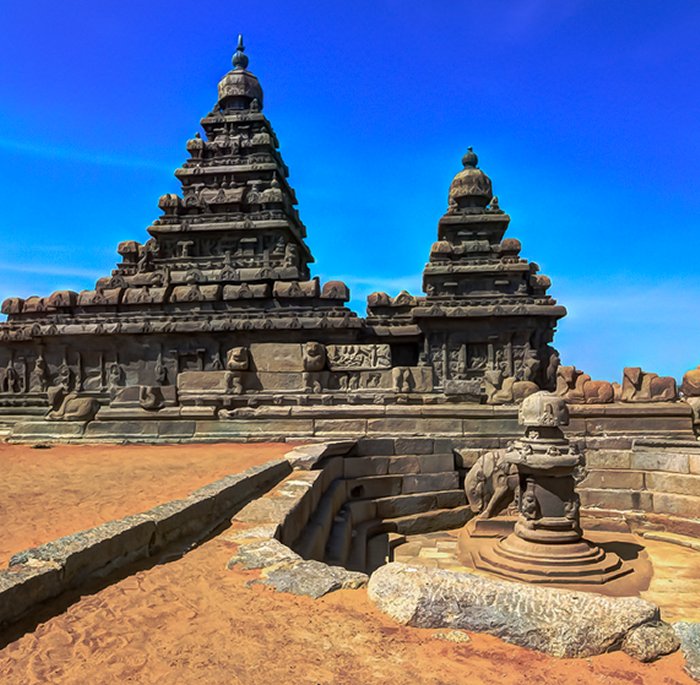 Shore temple, Mahabalipuram, India. Image credit: Balasubramanian S - CC BY-SA 3.0
Shore temple, Mahabalipuram, India. Image credit: Balasubramanian S - CC BY-SA 3.0
It has a 16 sided lingam and a relief of Somaskanda, a form of Shiva dated to the early Pallava period (275 AD to 897 AD) that became widely popular.
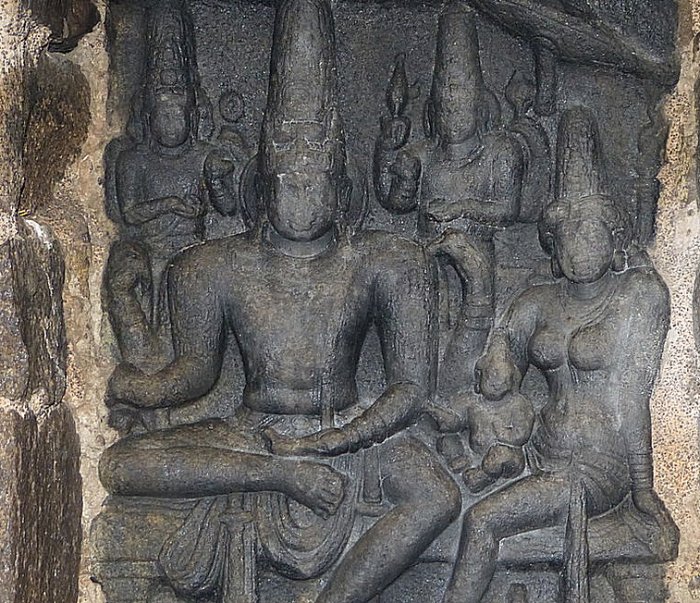 Somaskanda Panel with Shiva, Uma, and their son Skanda. Image credit: SatishKumar- CC BY-SA 3.0
Somaskanda Panel with Shiva, Uma, and their son Skanda. Image credit: SatishKumar- CC BY-SA 3.0
Yet another architectural attraction of Mahabalipuram is a spectacular and massive open-air bas-relief sculpted out of pink granite. The boulder is carved with 153 different deities, humans, and various animals carved on it.
This relief is like the Mahabharata epic poem with beautiful mythical scenes, battles, and figures of animals, beings, gods, and goddesses. It also depicts the story of Arjuna doing penance to attain a weapon from Lord Shiva to fight his enemies. It also shows the story of the Ganges descent from the Himalayas.
 Arjuna's Penance relief. Image credit: Sainath adapa _ CC BY-SA 3.0
Arjuna's Penance relief. Image credit: Sainath adapa _ CC BY-SA 3.0
The open-air bas-relief was carved on the face of two gigantic, connecting boulders, approximately 96 feet long (29 meters) and 43 feet (13 meters) high. The brilliant artwork dates back to the mid-seventh century.
The concept of the story includes an essential piece of Hindu philosophy. It says that a person could, by penance, the infliction of pain, or other discomforts on oneself, reach miraculous blessings from the Gods.
The ‘Descent of Ganges’ story, on the other hand, describes the penance of the Sage Bhagirathi, who performed austerities to bring Goddess Ganges down to earth.
Written by – A. Sutherland - AncientPages.com Senior Staff Writer
Copyright © AncientPages.com All rights reserved. This material may not be published, broadcast, rewritten or redistributed in whole or part without the express written permission of AncientPages.com
More From Ancient Pages
-
 New Details On Discovery Of San Jose 300-Year-Old Shipwreck That Sank With Treasure Of Gold, Silver, And Emeralds
Archaeology | May 23, 2018
New Details On Discovery Of San Jose 300-Year-Old Shipwreck That Sank With Treasure Of Gold, Silver, And Emeralds
Archaeology | May 23, 2018 -
 2,000-Year-Old Historical Tombs Unearthed In Close Vicinity To Ancient City Of Laodicea
Archaeology | Jan 23, 2020
2,000-Year-Old Historical Tombs Unearthed In Close Vicinity To Ancient City Of Laodicea
Archaeology | Jan 23, 2020 -
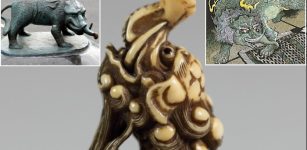 Legend Of Baku – The Dream Eater – Was It An Ancient Supernatural Being?
Featured Stories | Feb 15, 2023
Legend Of Baku – The Dream Eater – Was It An Ancient Supernatural Being?
Featured Stories | Feb 15, 2023 -
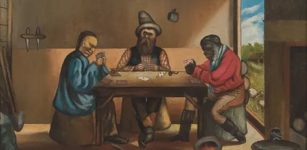 How Gold Rushes Helped Make The Modern World
Featured Stories | Aug 1, 2019
How Gold Rushes Helped Make The Modern World
Featured Stories | Aug 1, 2019 -
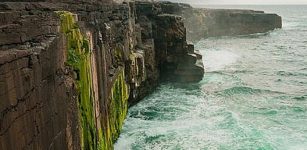 Intriguing Genetics: First Ancient Irish Human Genomes – Sequenced
Archaeology | Dec 29, 2015
Intriguing Genetics: First Ancient Irish Human Genomes – Sequenced
Archaeology | Dec 29, 2015 -
 ‘Sesselfelsgrotte Cave’ – Innovative Neanderthals Adjusted To Climate Change By Creating More Complex Tools
Artifacts | Aug 31, 2020
‘Sesselfelsgrotte Cave’ – Innovative Neanderthals Adjusted To Climate Change By Creating More Complex Tools
Artifacts | Aug 31, 2020 -
 Homo Erectus Was Too Lazy And Went Extinct
Archaeology | Aug 14, 2018
Homo Erectus Was Too Lazy And Went Extinct
Archaeology | Aug 14, 2018 -
 47,000 Years Of Aboriginal Heritage Was Destroyed In Mining Blast – Results From Juukan Gorge Show
Featured Stories | Jul 22, 2024
47,000 Years Of Aboriginal Heritage Was Destroyed In Mining Blast – Results From Juukan Gorge Show
Featured Stories | Jul 22, 2024 -
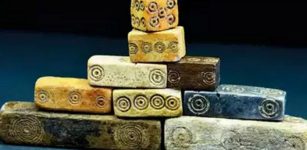 Millennium Old Dice Found In Vadnagar, Gujarat, India
Archaeology | Apr 25, 2022
Millennium Old Dice Found In Vadnagar, Gujarat, India
Archaeology | Apr 25, 2022 -
 Neanderthals Vanishing When Homo Sapiens Emerged In Europe Was Coincidental – Are Herbivores The Answer?
Evolution | Sep 29, 2023
Neanderthals Vanishing When Homo Sapiens Emerged In Europe Was Coincidental – Are Herbivores The Answer?
Evolution | Sep 29, 2023 -
 Mystery Of The First Dinosaurs Deepens – Is The Supercontinent Gondwana The Answer?
Paleontology | Jan 24, 2025
Mystery Of The First Dinosaurs Deepens – Is The Supercontinent Gondwana The Answer?
Paleontology | Jan 24, 2025 -
 Illness And Death Of The Edward Of Woodstock ‘Black Prince’ Changed The Course Of English History
Archaeology | Dec 21, 2022
Illness And Death Of The Edward Of Woodstock ‘Black Prince’ Changed The Course Of English History
Archaeology | Dec 21, 2022 -
 Mysterious High-Energy Particles Detected In Antarctica – Evidence Of Ancient Nuclear Technology Or Something More Frightening?
Ancient Mysteries | Sep 11, 2019
Mysterious High-Energy Particles Detected In Antarctica – Evidence Of Ancient Nuclear Technology Or Something More Frightening?
Ancient Mysteries | Sep 11, 2019 -
 Unclear Purpose Of Mysterious Rock-Cut City Of Petra – Was It A Fortress Or Sacred City?
Featured Stories | May 30, 2020
Unclear Purpose Of Mysterious Rock-Cut City Of Petra – Was It A Fortress Or Sacred City?
Featured Stories | May 30, 2020 -
 Secrets Of A Lake That Could Re-Write Ancient History Of America – Interesting Artifacts And Buildings – Part 2
Ancient Mysteries | Jun 5, 2018
Secrets Of A Lake That Could Re-Write Ancient History Of America – Interesting Artifacts And Buildings – Part 2
Ancient Mysteries | Jun 5, 2018 -
 Sumerian ‘Mask Of Warka’ From Uruk: Sculptured Face May Depict Goddess Inanna
Featured Stories | Sep 15, 2016
Sumerian ‘Mask Of Warka’ From Uruk: Sculptured Face May Depict Goddess Inanna
Featured Stories | Sep 15, 2016 -
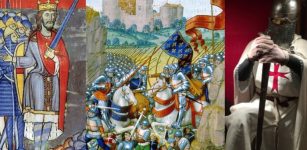 House Of Plantagenet – How Hatred, Revenge And Jealousy Transformed History
Featured Stories | Jul 27, 2018
House Of Plantagenet – How Hatred, Revenge And Jealousy Transformed History
Featured Stories | Jul 27, 2018 -
 Archaeologists Discover A Secret Escape Tunnel In Copenhagen, Denmark
Archaeology | May 5, 2020
Archaeologists Discover A Secret Escape Tunnel In Copenhagen, Denmark
Archaeology | May 5, 2020 -
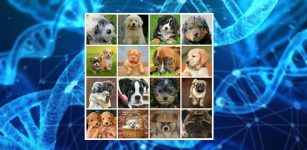 DNA Sheds Light On Ancient History Of Dogs All The Way To The Ice Age
Archaeology | Oct 30, 2020
DNA Sheds Light On Ancient History Of Dogs All The Way To The Ice Age
Archaeology | Oct 30, 2020 -
 Who Built The Mysterious Huapalcalco Pyramid – Mexico’s Smallest Pyramid?
Featured Stories | Mar 29, 2018
Who Built The Mysterious Huapalcalco Pyramid – Mexico’s Smallest Pyramid?
Featured Stories | Mar 29, 2018


